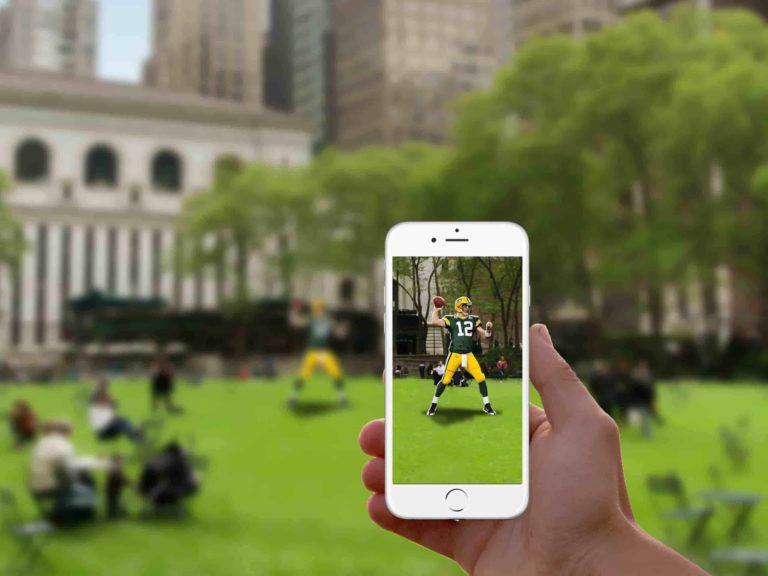
One of the ways mobile AR can create value is to deepen fan experiences in sports. Future-gazing use cases typically include getting live informational overlays on players and plays. This could be a natural fit for such a stats-heavy area of entertainment. Moneyball meets 3D.
Back to the present, we continue to see sports organizations use AR as a tool to market themselves. And let’s not forget that the NFL is one of the original AR adopters, given virtual first-down markers (that yellow line across the field) displayed on game broadcasts.
Specific team AR activations include the Dallas Cowboys’ giant Dak Prescott animation that comes to life for fans outside of AT&T stadium. More recently, the Oregon Ducks broadcasted an AR promo for Halo Infinite, in which the game’s protagonist virtually descended on the field.
Similarly, the Carolina Panthers launched a pre-game AR animation of a giant panther prowling around Bank of America Stadium (video below). This produced a sizeable uptick in fan engagement when compared to benchmarks in the team’s other marketing formats.
Second Screen
Drilling down on the Panthers’ example, it was shown on the stadium jumbo screens prior to the game, as well as game broadcasts and on-demand channels like YouTube and Twitter. These represent promising AR channels due to their scale, especially when used in combination.
For example, the Twitter post that included a video of the AR animation has been viewed 6 million times. The team reports that this is 46x the engagement levels seen in its other video tweets (see below). Some of this was due to novelty and a viral effect among Panthers fans.
Stepping back, there’s a key distinction in these AR formats. The Panthers campaign was a passive AR experience that was simulated through a recorded video. The Dallas Cowboys AR animation noted above was conversely a persistent and interactive onsite AR experience.
Breaking down the pros and cons of these modalities, the broadcasted AR video that you watch passively on your couch during a game can achieve massive reach. But live onsite AR experiences through your smartphone camera are more active and immersive.
The next step is to combine the two. Broadcast media can distribute AR calls to action – say, an on-screen QR code – that prompts an interactive AR animation. That could be a 3D replay on your coffee table that you watch from every angle. It’s “second-screen” viewing on steroids.
The most impactful content across the NFL this week as compared to each teams’ 30-day averages
These posts from @Panthers & @dallascowboys saw 46x, 7.6x, and 38x more engagements than avg. respectively. And that Panthers video is going to keep growing 👀
(5/11) pic.twitter.com/YNJHEFfHFn
— Geoffrey Blosat (@GeoffTBlosat) September 15, 2021
AR Training Wheels
Expanding on broadcast AR’s advantages, though it’s more passive, its reach is valuable for AR acclimation in the technology’s early stages. Indeed, AR already has enough adoption barriers without requiring users to be in a specific place. It should meet fans where they are.
And that’s a key factor in sports, given the proportional makeup of consumption points. For example, 99 percent of NBA fans will never enter an arena. So broadcasted AR campaigns bring the action to the fans, while also offering them more animated fare than standard broadcasts.
Beyond engagement rates validated by the Panthers, a second-order effect of mass-broadcasting “passive” AR is to seed demand for the real thing. That way, consumers are more driven to pull out their phones next time they see an AR call-to-action in a stadium or store aisle.
This makes broadcasted AR experiences sort of like training wheels for AR. In that light, AR couldn’t ask for better boost given the size and intensity of some fan bases (looking at you Raider Nation). Along with social lenses, this could serve as a meaningful AR accelerant.
Header image credit: AR Sports

